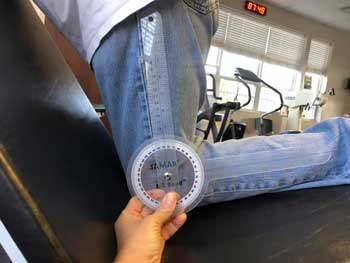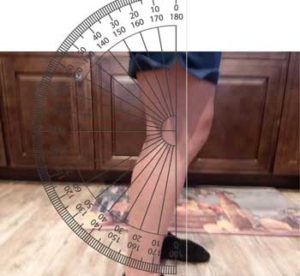3 EASY Ways to Measure Knee Flexion at Home
NEW technology can make it easy to measure knee flexion range of motion at home!
After a total knee replacement it is important to monitor progress.
As a physical therapist I prefer my clients monitor progress based on function. If you can not stand from the commode the day after surgery, but then you are able to do it 3 days after surgery, then that is a huge win in my book.
This electronc goniometer is really great because it will provide you with a large and easy to read display. Click here to check pricing and possible discounts on Amazon.
This device can help you measure knee flexion at home as well as knee extension.
Simple ways to measure progress based on functional include:
- How long are you able to stand on your feet?
- Are you able to stand from the commode without using your hands?
- Are you able to walk up stairs with a step over step gait pattern?
- Are you able to stand from your couch without pushing yourself up?
- After long in minutes or far in distances are you able to walk without an assistive device?
These are all great function based milestones to track progress during the first 12 weeks of recovery.
3 Best Ways To Measure Knee Range of Motion At Home
1 – Using a camera phone to take photos of your knee flexion and extension
2 – Having a family member or friend use a goniometer

3 – Using a flexible tape measure to measure progress not degrees
Another way to measure progress is Range of Motion (ROM).
Range of motion is most commonly measured in degrees.
When your knee is straight, fully extended, then this is called full knee extension. Normal range of motion for knee extension is 0-degrees. See photo below –

Measure Knee Flexion ROM after Knee Replacement
When your knee is bent, fully flexed, this is called knee flexion. Normal knee flexion after a total knee replacement may range between 120-degrees and 135-degrees. Some implants may provide for greater range of motion.
If you were sitting in a chair with your ankle directly under your knee this would be roughly 90-degrees of knee flexion.
For an individual without a total knee replacement, pulling your heel to your backside would be roughly 150-degrees of motion.
What is Active versus Passive Range of Motion?
Active knee range of motion is the available movement your knee has without adding pressure. For example, in the photo below this patient has taken a photo of herself with her knee in full active flexion. She is only using the muscles of her leg to bend her knee.
An example of active knee extension would be a patient sitting in a chair kicking her knee straight against gravity without using a strap to step stoop to help.
Passive range of motion involves the patient or a therapist pushing the knee into flexion or extension. It is common to achieve greater range of motion during passive range of motion simply because you are able to apply over pressure to the extremity and take the joint through a complete range of motion.
In physical therapy we often document both active and passive range of motion.
How long do I have to achieve full range of motion?
Some studies suggest achieving full range of motion in the first 8 weeks may lead to the best possible outcome. But it is important to understand that every patient is different.
Some factors to consider when determining your goal range of motion:
-
- How much range of motion did you have before surgery?
- How active were you before surgery?
- How strong were your legs before surgery?
- How old are you?
- How long was your activity level limited before surgery?
- How well is your pain control following surgery?
- Have you had other complications that may affect tissue healing?
“You can imagine a 40-year old athlete may have an easier time gaining full range of motion in 8 weeks than an 82-year old adult male who has been unable to walk, kneel, squat, or crawl for 5 years due to severe knee pain.”

Anthony Maritato, PT
Physical Therapist
Anthony Maritato, PT has been a licensed physical therapist and private practice owner since 2006. Ohio license #PT011602.
Anthony has been passionate about helping patients recover from total knee replacement surgery as well as rotator cuff repair surgery.
Recommended Best Bike in 2022
About the Author -
Anthony Maritato, PT has been a licensed physical therapist since 2006. He specializes in post surgical care and rehabilitation of total knee replacement and rotator cuff repair surgery.
Mr. Maritato is also nationally recognized as a therapist educator teaching courses related to Medicare reimbursement, contracting, and documentation.
Total Therapy Solutions LLC is Tony's primary practice which he owns with his wife Kathy who is also a licensed physical therapist.
